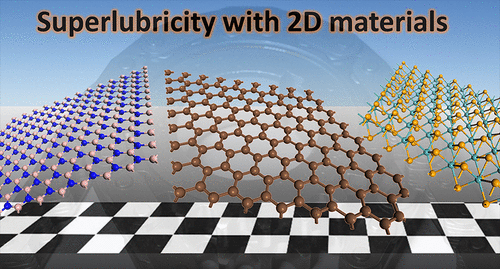Our official English website, www.x-mol.net, welcomes your feedback! (Note: you will need to create a separate account there.)
Approaches for Achieving Superlubricity in Two-Dimensional Materials
ACS Nano ( IF 17.1 ) Pub Date : 2018-03-09 00:00:00 , DOI: 10.1021/acsnano.7b09046 Diana Berman 1 , Ali Erdemir , Anirudha V. Sumant
ACS Nano ( IF 17.1 ) Pub Date : 2018-03-09 00:00:00 , DOI: 10.1021/acsnano.7b09046 Diana Berman 1 , Ali Erdemir , Anirudha V. Sumant
Affiliation

|
Controlling friction and reducing wear of moving mechanical systems is important in many applications, from nanoscale electromechanical systems to large-scale car engines and wind turbines. Accordingly, multiple efforts are dedicated to design materials and surfaces for efficient friction and wear manipulation. Recent advances in two-dimensional (2D) materials, such as graphene, hexagonal boron nitride, molybdenum disulfide, and other 2D materials opened an era for conformal, atomically thin solid lubricants. However, the process of effectively incorporating 2D films requires a fundamental understanding of the atomistic origins of friction. In this review, we outline basic mechanisms for frictional energy dissipation during sliding of two surfaces against each other, and the procedures for manipulating friction and wear by introducing 2D materials at the tribological interface. Finally, we highlight recent progress in implementing 2D materials for friction reduction to near-zero values—superlubricity—across scales from nano- up to macroscale contacts.
中文翻译:

在二维材料中实现超润滑的方法
从纳米级机电系统到大型汽车发动机和风力涡轮机,控制摩擦并减少运动中的机械系统的磨损在许多应用中都很重要。因此,致力于设计材料和表面以进行有效的摩擦和磨损操纵。二维(2D)材料的最新进展,例如石墨烯,六方氮化硼,二硫化钼和其他2D材料,为保形,原子薄的固体润滑剂开辟了一个时代。但是,有效结合2D薄膜的过程需要对摩擦的原子起源有基本的了解。在这篇评论中,我们概述了两个表面彼此相对滑动时摩擦能耗散的基本机制,以及在摩擦学界面处引入2D材料来控制摩擦和磨损的过程。最后,我们重点介绍了在从纳米级到宏观接触的整个尺度上,采用2D材料将摩擦降低到接近零值(超润滑性)方面的最新进展。
更新日期:2018-03-09
中文翻译:

在二维材料中实现超润滑的方法
从纳米级机电系统到大型汽车发动机和风力涡轮机,控制摩擦并减少运动中的机械系统的磨损在许多应用中都很重要。因此,致力于设计材料和表面以进行有效的摩擦和磨损操纵。二维(2D)材料的最新进展,例如石墨烯,六方氮化硼,二硫化钼和其他2D材料,为保形,原子薄的固体润滑剂开辟了一个时代。但是,有效结合2D薄膜的过程需要对摩擦的原子起源有基本的了解。在这篇评论中,我们概述了两个表面彼此相对滑动时摩擦能耗散的基本机制,以及在摩擦学界面处引入2D材料来控制摩擦和磨损的过程。最后,我们重点介绍了在从纳米级到宏观接触的整个尺度上,采用2D材料将摩擦降低到接近零值(超润滑性)方面的最新进展。


























 京公网安备 11010802027423号
京公网安备 11010802027423号